|
The .357 Magnum was introduced in 1935 when S&W unveiled the Registered Magnum.
The original load development was carried out by Phil Sharpe, and much of his
work was centered around bullets cast from 2 moulds made for him by George
Hensley (this was before Hensley had teamed up with Gibbs). Originally known as
“the Sharpe solid” and “the Sharpe hollow point”, these bullets would later be
known as the H&G #51 SWC and #51 HP. The Sharpe solid had a nominal weight of
160 grains, and the Sharpe HP had a nominal weight of 146 grains (both weights
depend on the alloy used).
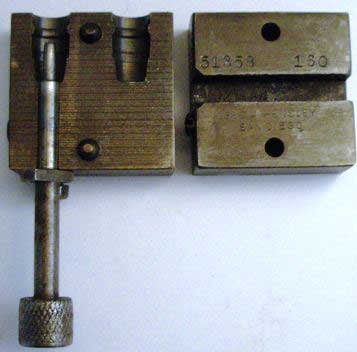 |
|
George
Hensley #51 and #51 HP mould. |
|
Sharpe started off with Elmer Keith’s 358429 SWC design and shortened it to 5/6
of the original length so it would function in the cylinder of the S&W .357
Magnum. Sharpe reported very high velocities with the 146 grain Sharpe HP in the
.357 Magnum, as well as explosive terminal performance. This level of
performance helped to cement the reputation of The Magnum in the 1930s and added
to its mystique.
For the first 20 years of the .357 Magnum, most ordinary folks couldn’t afford
to own one due to the high price of the Registered Magnums. Then in the
mid-1950s S&W brought out the Combat Magnum (later called the Model 19) and the
.357 Magnum became a lot more affordable and sold like hot-cakes.
There were some issues with cast bullets in the .357 Mangum in the early days.
Factory lead ammo was reputed to lead horribly (probably due to poor lube and
too little). Elmer Keith’s 358429 had a nose that was too long for the N-frame
S&W’s (when loaded into Magnum brass and crimped in the crimp groove). Lyman had
the 358443 and 358446, and later Ray Thompson’s gas-checked 358156, but while
all of these worked just fine in all .357 Magnum sixguns, none of Lyman’s
designs captured the features that Elmer Keith had long espoused -- a SWC with 3
equal width driving bands, a beveled crimp groove, and one large grease groove.
At about the same time that S&W made the .357 Magnum affordable to the masses by
introducing the Combat Magnum, Lyman introduced the 150 grain 358477. I am
guessing that Lyman was looking to make bullet casters think about high velocity
loadings for the .357 Magnum (remember, this was the 1950s and high velocity was
all the rage), and do so in a Keith-style SWC that Elmer Keith had been
promoting for decades (one little detail that they missed was the grease groove
-- Elmer did not like the rounded grease groove that Lyman was using, but it IS
a large grease groove and lube capacity was Keith’s primary concern). The
original 150 grain 358477 is an excellent bullet in the .357 Magnum and arguably
one of the best bullets ever designed for the timeless .38 Special. Lyman has
changed the design over the years, to a smaller grease groove, different driving
band widths, shorter nose, heavier weight (158 grains), and the newer bullets
shoot just fine, but the older 150 grain design of the 385477 has always
remained a personal favorite of mine. Maybe that has to do with the fact that
Reo Rake (the guy who got me started in bullet casting), gave me my first 358477
mould many years ago with the curt admonition that, “Everybody needs a good .38
SWC mould.” (I still have, and use, that mould). It might be a personal favorite
because it looks “balanced” with a proper SWC nose, 3 equal width driving bands
and a big grease groove. Perhaps it’s a personal favorite because it shoots so
well and I’ve shot untold thousands of them over the last 20+ years. Maybe it’s
a little of all of the above, does it really matter? The bottom-line is it’s a
darned fine bullet, and a favorite of mine and many other sixgunners.
Recently, interest in the old 150 grain version of the 358477 has been
resurging, and bullet casters have been hunting down the old moulds and putting
together group buys for newly manufactured copies of this fine design. Good
designs simply refuse to die.
I have long been a fan of cast HP’s for hunting, and I like to use cast HP’s in
my revolvers for summer varmint hunting. The .38 Special is very well-suited to
such pastimes. The Keith HP (Ideal 358439) 154 grain HP is an excellent varmint
bullet when launched at 1050 fps, but this is a +P load and I don’t care to
shoot +P level ammo in my older .38 Special revolvers. I wanted a cast HP design
that captured the features of the Ideal 358439, but did so in a somewhat lighter
bullet that could be pushed from the .38 Special revolver at 1000 fps at
standard .38 Special pressures (15-16,000 psi peak pressure). But I also wanted
the bullet to be heavy enough that it would still shoot to the sights of my
fixed sight .38 Specials (e.g. M&P‘s, SP-101s, etc.). This led me to focus on a
bullet weight of about 140-145 grains, and powders in the burning range of
Unique and HS-6. A HP version of the old 150 grain 358477 looked like it might
be just the ticket!
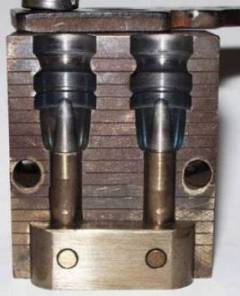 |
|
The
2-cavity Ideal 358477 mould as HP-ed by Erik Ohlen. |
|
I dug around in the mould box and found a spare old-style 2-cavity 358477 and
sent it off to Erik Ohlen (http://www.hollowpointmold.com/,
erik@hollowpointmold.com, (541) 738-2479) for conversion to a
2-cavity HP using what he calls the “inset bar conversion (but I call it “the
Ohlen HP”). The design specs I sent him were: .150” diameter cavity, .300” deep,
7 degree taper, and rounded HP pins. A little while later, the mould was
returned and it captured my intentions to a “T”. Firing up the lead pot, this
mould cast beautifully right out of the gate (sometimes the HP pins can be a
little sticky at first on these moulds, but not this time). It cast these
bullets quickly and easily, and released them smoothly. Maintaining a casting
cadence of 5-6 HP’s a minute was no problem. I cast up a batch using recovered
range scrap (BHN of about 8) and the HP cavities were perfectly centered, the
bullets were nice and round and they weighed 143 grains. Just what I was looking
for!
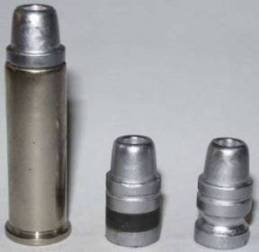 |
|
The
358477 HP loaded in .38 Special. |
|
These bullets were sized .358” and lubed with my homemade Moly lube. A variety
of test loads were assembled and test-fired. The best two loads were 5.5 grains
of Unique and 7.0 grains of HS-6 (I used Winchester Small Pistol primers for
these test loads). According to published pressure data, both of these loads
operate at 15-16,000 psi peak pressure, and both deliver about 1000 fps
(depending on barrel length). Both loads gave me good accuracy (1 ¼” at 50 feet
from target guns and 1 ½” to 2” from snubbies and service revolvers). I was very
pleased to learn that the 143 grain 358477 HP shot to the sights from the fixed
sight guns with these loads. Expansion testing revealed that the 358477 HP
expands very nicely at 1000 fps when cast to a BHN of about 8 (25-1 alloy works
very nicely at this velocity).
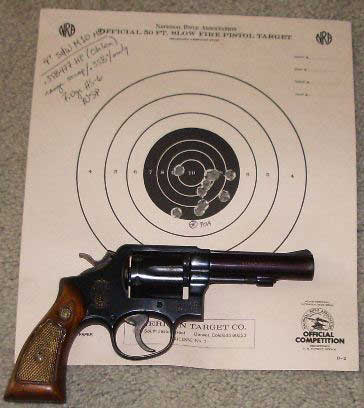 |
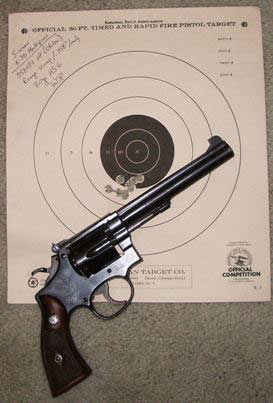 |
|
The 358477 HP is very
accurate in this favorite 5-screw K-38 Target Masterpiece. |
The 358477 HP is a real screamer in the .357 Magnum. For the .357 Magnum I cast
the 358477 HP using an alloy with a BHN of about 11. These bullets were sized
.358” and lubed with my homemade Moly lube and loaded on top of 15.0 grains of
2400 and sparked with a CCI 550 primer. This 143 grain cast HP load will
generate 1600 fps from my 8 3/8” S&W 586 and makes for a flat-shooting and
highly explosive varmint load.
The bottom-line is that the 358477 HP is an excellent bullet for both the .38
Special and the .357 Magnum. A 2-cavity HP mould allows one to cast 5-6 HP’s a
minute, and the 143 grain 358477 HP is an accurate bullet. It is heavy enough to
shoot to the sights in fixed sight revolvers, and light enough that it can
achieve ~1000 fps while staying within SAAMI pressure specs for the .38 Special.
It expands very nicely in the .38 Special, and explosively in the .357 Magnum. I
highly recommend this conversion.
|